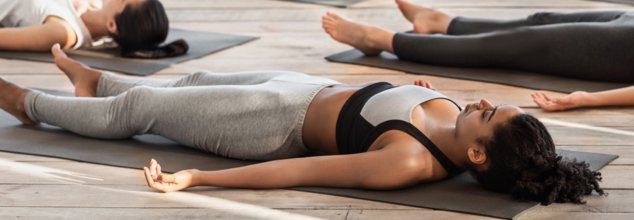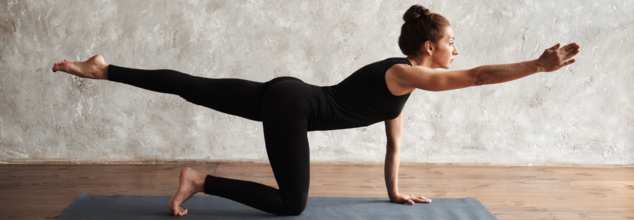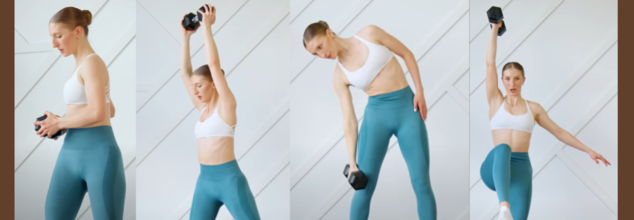- Health Conditions A-Z
- Health & Wellness
- Nutrition
- Fitness
- Health News
- Ayurveda
- Videos
- Medicine A-Z
- Parenting
- Web Stories
Stressed And Insomniac? Yoga Poses That Can Help You Sleep Better

(Credit-Canva)
Yoga is a great way to connect your mind and body. It helps us process our body’s well-being through gentle and flow-based movements, allowing us to have a relaxing and stress-free time. When you are doing yoga, you are told to be conscious of your breathing and focus on your surroundings. That helps one feel collected and focus better.
It is very easy to get caught up in stressful situations, causing anxiety and distress to people. This has a negative effect on your body and can manifest in ways like acne, headaches, fatigue as well as insomnia. When one is feeling these things, the best way to cope with these issues is by doing yoga.
Can Yoga Really Help with Insomnia?
A 2020 review published in the BMC Psychiatry, found that yoga generally helped women with insomnia sleep better. The researchers noted that it seemed particularly helpful for women experiencing menopause.
While not every study in the review showed a positive effect from yoga, they all agreed that yoga didn't have any bad side effects. This suggests that trying yoga for sleep is a safe first step before considering other treatments. Another review in 2019 also found that mind-body practices like yoga significantly improved sleep problems in previous research.
Yoga Asanas That Can Help With Insomnia
Legs Up The Wall (Viparita Karani)
Start by sitting sideways near a wall with your legs straight. As you breathe out, lower your upper body to the floor and lift your legs up against the wall. Keep your arms relaxed by your sides, palms up. You can use a pillow under your lower back for comfort. To stretch your inner thighs more, let your legs gently fall open while they are still resting on the wall.
Child’s Pose (Balasana)
Kneel on the floor with the tops of your feet flat. Bring your knees and feet together so your big toes touch. Sit back gently on your heels. Lean forward and fold your upper body over your legs until your forehead touches the floor or gets close. You can rest your arms by your sides or stretch them forward. Breathe calmly and stay in this comfortable position.
Reclined Butterfly Pose (Supta Baddha Konasana)
Lie comfortably on your back with your legs and arms straight. Bend your knees and bring your feet towards your body, letting the soles of your feet touch. Gently bring your clasped hands to rest on your stomach. Stay in this relaxed position and focus on your natural, easy breathing.
Corpse Pose (Savasana)
This is a great pose to end your yoga practice and can also be used for quiet meditation. Lie flat on your back with your legs and arms straight and relaxed. Let your hands be open with palms facing up, and allow your ankles to gently fall open. Take a deep breath and consciously relax all the muscles in your body. Keep your attention on your breath. To finish, gently move your fingers and toes, then slowly roll to one side and sit up.
New Research Links Narrowed Visual Attention To Faster Running Pace

Credits: Canva
If you’re aiming to improve your running speed and endurance, it may be time to shift your gaze — quite literally. A new study suggests that narrowing your focus while running, especially as you near the finish line, can help you move faster and push harder.
The research, published on June 25 in the journal Personality and Social Psychology Bulletin, looked at the performance of nearly 1,600 runners across six separate studies. Conducted by researchers from Rutgers University, New York University, and Creighton University, the findings point to a low-cost and highly effective strategy known as “attentional narrowing.”
Put simply, runners who directed their gaze straight ahead — instead of looking around — not only moved faster but also exerted more physical effort.
Attentional Narrowing: What the Science Says
“The findings offer a low-cost and simple way to improve running performance — merely by adjusting how we direct our attention,” said Dr. Shana Cole, associate professor of psychology at Rutgers University-New Brunswick.
In the study, both elite and casual runners were surveyed and tested. Some participants were asked to maintain a narrow focus throughout their run, while others were instructed to shift their attention only in the final stretch. The races varied between 400 meters and one mile, but the result was consistent: those who fixed their eyes on a single point ahead — like the finish line — ran faster and registered higher heart rates, indicating increased effort.
“Looking at one spot ahead of you — rather than around you — can help you keep going,” added lead author Emily Balcetis, associate professor of psychology at New York University.
Co-author Corey Guenther, psychology professor at Creighton University, emphasized that the mental strategy doesn’t just correlate with better results — it causes them. “The studies show that narrowing attention isn’t just correlated with performance. It actively enhances it,” he said.
Why Running Is Already Good for You
This simple mental tweak could make running even more beneficial — and that’s saying something. Running is well-known for its wide-ranging health perks. According to a 2019 study published in the British Journal of Sports Medicine, even small amounts of running (as little as once a week) are associated with a significantly lower risk of death from all causes, including cardiovascular disease and cancer.
Running also helps with weight control, strengthens the heart, improves sleep, and releases endorphins — the feel-good hormones — which help reduce stress and anxiety. The Centers for Disease Control and Prevention (CDC) recommends at least 150 minutes of moderate-intensity aerobic activity per week for adults, and running is a quick and efficient way to meet that goal.
The Takeaway: Pick a Spot and Go for It
The study findings offer a practical, science-backed takeaway: when running, particularly in challenging stretches, resist the urge to look around. Instead, fix your eyes on a point ahead — a tree, a marker, or the finish line — and stay focused.
As Balcetis explained, “A simple shift in attention can lead to better outcomes — mentally and physically.”
So the next time you're out on a run, remember: where your eyes go, your legs may just follow.
15-Minute Yoga Poses That Will Energize You For The New Week

(Credit-Canva)
After a nice, relaxing weekend, going back to work can feel hard. Thinking about Monday mornings and all your tasks can make you miss your easy weekend days.
Unlike other exercises that push you hard and often leave you feeling drained and tired, yoga energizes you differently. It works by waking up your body, calming your mind, and improving your breathing, which helps you feel refreshed and focused without feeling worn out.
Start Your Week With Energizing Yoga
To help you get rid of any leftover weekend laziness and feel fresh, clear, and ready for your work, try a quick yoga routine. These 15-minute yoga poses are made to give your body and mind energy, helping you start the new week feeling lively and positive.
Cat-Cow Pose
This gentle movement, flowing from hands and knees as you arch your back like a cow then round it like a cat, warms up your entire spine, making it more flexible and improving blood flow. It deeply connects your breathing with your movement, which helps you feel more awake and aware, promoting a sense of calm readiness to start your practice.
Downward-Facing Dog
From hands and knees, lifting your hips high to form an inverted "V" stretches your whole body, from your legs to your shoulders. As a mild inversion, it sends fresh blood to your brain, which helps you feel more alert, clear-headed, and gives you a good energy boost to start your day.
Sun Salutation
This flowing series of poses, including standing tall, bending forward, plank, and gentle backbends, serves as a complete warm-up for your entire body. It builds gentle heat inside and gets your energy moving throughout, perfectly matching your movements with your breath to calm your mind while energizing your body, preparing you well for whatever the week brings.
Warrior II
Stepping your feet wide, turning one foot out and bending that knee while extending your arms, is a strong standing pose that builds inner strength and helps you focus your mind. It opens up your hips and chest, giving you a feeling of expansiveness and vitality, helping you cultivate a strong, confident presence for the week ahead.
Tree Pose
Standing tall and balancing on one leg with the other foot placed on your inner ankle, calf, or thigh, this pose greatly improves your balance and concentration, very helpful for quieting a busy mind. It makes you feel steady, grounded, and stable, ideal for cultivating a calm yet energized presence, preparing you for a focused and balanced new week.
Seated Twist
Sitting with one leg bent and crossing over the other, then gently twisting your upper body, is excellent for stimulating your internal organs, aiding in cleansing and better digestion. It also wakes up your spine and can release any built-up tension, leaving you feeling refreshed and lighter in both body and mind.
Easy Pose with Breathwork
Sitting comfortably cross-legged with closed eyes, focusing on deep, steady breaths helps integrate all the benefits of the poses. This mindful breathing calms your nervous system, leaving you feeling truly centered and mentally clear, ultimately preparing you to face the new week with renewed energy and a peaceful mind.
Train Your Core The 'Right Way' With This 15-Minute Standing Abs Workout

Credits: Youtube/@Madfit
When it comes to building a strong, functional core, most people instinctively think of sit-ups or crunches. A strong core is foundational to total-body strength and stability but when it comes to core training, not all ab exercises are created equal. While floor crunches have long been a staple in the fitness community, trainers and enthusiasts alike are pivoting toward a more dynamic and effective approach: standing core workouts.
This isn’t just about aesthetic abs. Standing ab workouts engage more muscles, improve balance, and reflect the way we use our core in daily activities. Fitness expert and YouTuber Maddie Lymburner, shared a workout video on Youtube emphasizes, "I believe in training the core while standing because it forces the abs and the other midsection muscles to engage to keep you stable."
A standing abs routine mimics how your core works in daily life—stabilizing, balancing, and powering your every movement. Here’s how you can transform your core training with Maddie’s dynamic, equipment-friendly 15-minute standing abs workout.
Why Standing Core Workouts Is Better Than Crunches?
Traditional floor exercises like crunches and sit-ups isolate the rectus abdominis, but they don’t fully engage the muscles that stabilize your spine and pelvis during real-world activities. Standing workouts, on the other hand, challenge your entire core—including the obliques, transverse abdominis, and lower back—by forcing your body to balance, twist, and resist gravity.
“Training your core while standing means your abs have to work the way they’re meant to work,” Maddie explains. “You’re not just lying down; you’re engaging your muscles to keep you upright, balanced, and strong.”
One of the best things about this routine is its accessibility. “You can use a dumbbell, a kettlebell, or whatever you have access to at home. It will work fine,” Maddie reassures. “Make sure that you can see your screen so you can follow along with me.”
The 15-Minute Standing Abs Workout, Round One
1. Single-Arm Dumbbell Marches
Start by holding a dumbbell in your right hand, lifting your right leg up, and lowering it slowly. This move tests your core stability and balance. Switch sides and repeat.
2. Standing Twists with Dumbbell
With a slight bend in your knees, hold the dumbbell in both hands and twist from side to side. "You're going to feel the resistance from the weight. We're going to work those obliques," says Lymburner.
3. Oblique Crunches with Dumbbell
With the dumbbell in your right hand, slide it down your leg and return to center. Then raise the weight overhead and lean to the opposite side. Repeat and switch arms. This move targets your side core muscles like no other.
4. Diagonal Leg Lifts
Holding the dumbbell above your head with both hands, bring one knee diagonally across your body and then open it to the side. "Bring that knee up as close as you can to your chest, and then to the side," Lymburner instructs. Repeat with the other leg.
5. Woodchoppers
Starting from a low position, bring the dumbbell up diagonally across your body while bracing your core. Repeat on both sides. "Think about using your core to move the body up, not your arms," says Lymburner.
6. Standing Elbow-to-Knee Crunches
Place your fingertips near your ears, bring your knee and elbow together at your center. This simple move is effective for working the entire midsection.
7. Dumbbell Passes Around the Waist
Pass the dumbbell around your body from one hand to the other. The trick is to stabilize your core so the rest of your body doesn’t sway. Go one direction in Round One and switch in Round Two.
Standing core exercises are rooted in functional fitness—the idea that training should prepare your body for real-life movements. Research shows that standing ab routines activate more muscle groups, improve posture, and boost calorie burn compared to traditional floor exercises. They also enhance balance, coordination, and athletic performance, making them ideal for everyone from beginners to seasoned athletes.
Tips for Getting the Most Out of Your Standing Abs Workout
Focus on Form: Keep your movements controlled and your core braced throughout each exercise.
Breathe: Exhale during the effort phase (e.g., lifting the knee or twisting) to maximize core engagement.
Start Light: Use a light weight to master technique before progressing to heavier loads.
Stay Consistent: Incorporate this routine 2–3 times per week for best results.
So the next time you think of core workouts, skip the mat. As Maddie Lymburner shows us, just a pair of dumbbells and 15 minutes can power up your posture, balance, and abs more efficiently than any crunch circuit ever could.
Disclaimer: Always consult with a healthcare provider before beginning any new exercise program, especially if you have any pre-existing conditions or injuries.
© 2024 Bennett, Coleman & Company Limited

